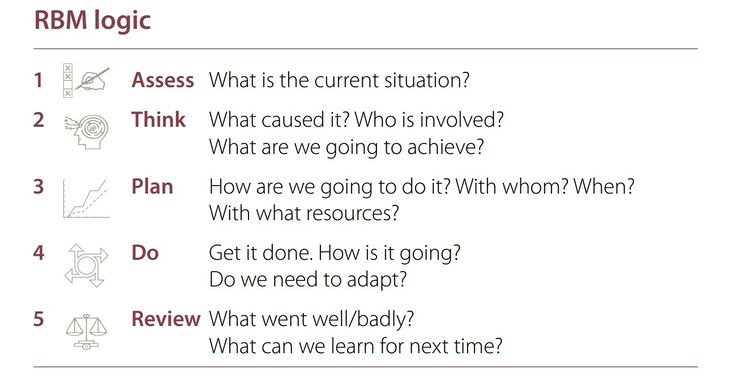Results Based Management
Original Editor - Kim Jackson
Top Contributors - Kim Jackson
Introduction[edit | edit source]
Results-based management (RBM)is a tool, often used in business, that uses feedback loops to monitor and evaluate the outcomes and impact of strategies and projects[]. The aim is to introduce a structured approached that focuses on the expected results rather than the implementation and budgets. It is a strategy adopted from the private sector, where it was used to track financial results. [] The aim is to introduce a structured approached that focuses on the expected results rather than the implementation and budgets. Measuring results helps teams to understand the importance and value of their work.[]
In healthcare this can be an invaluable tool when assessing the implementation of standards and procedures. It provides a structured framework for monitoring the expected results at each step of the project, the steps needed to be taken to achieve them and also evaluates the impact on the service and target audience[]
Although it is a strategy adopted from the private sector it is important to understand there are differences between the private sector and the healthcare sector. In healthcare humanitarian/social interventions are designed to benefit people and the quality of the outcomes depend on the quality of of the organisation. The organisation responsible for implementing the interventions have an ethical responsibility and need to consider local capacities, culture and vulnerabilities and ensure that the outcomes and benefits reflect the needs of the population. Unlike in the private sector, where people have choices to choose between, providers, goods and services, in the humanitarian sector, people are not usually in a position to choose the aid they receive or where it comes from.[] This why strategies like RBM can promote ethical responsibility, by ensuring the focus is on performance and results.[]
The Results Chain[edit | edit source]
Th results chain explains an intervention in terms of inputs and activities where the results can be categorised as outputs, outcomes and impacts. The results of an intervention be described as:
- Intended or unintended
- Positive or negative
RBM will have different implications and meaning depending on the level of operation. Coordinators will focus more on outcomes whereas those who have a more hands on approach and work in the field will focus more on outputs.
ICRC IMAGE - RESULTS CHAIN
Outputs[edit | edit source]
Outputs are the results of an intervention, for example products, capital goods or services. Outputs are the first results seen from an intervention or activity.[]
Outcomes[edit | edit source]
Outcomes are the predicted or achieved medium-term effects of an intervention's outputs. There is less control over an outcome than an output but outcomes are a significant factor in the chain as they represent the real changes that are expected from any given intervention.
Impacts[edit | edit source]
Impacts are the reason, and justification, why an intervention was identified. The impact of all the efforts of the previous steps represents the effectiveness of the desired goal. The end results may not always reflect the expected goal and can be viewed as positive or negative, direct or indirect, intended or unintended.
Project Cycle Management Planning for Results[edit | edit source]
Project Cycle Management (PCM) describes the process of planning and managing projects. Setting clear goals and objectives will help to plan for better results. The project cycle helps to guide the RBM by outlining the steps that lead to successful outcomes. Pr
The ICRC describes planning for results as "A corporate function that assesses context, target groups, problems/needs, risks, constraints and opportunities and sets priorities to ensure an appropriate level of coordination and alignment of actions and resources towards the achievement of expected results"[]
Objectives[edit | edit source]
When setting objectives in healthcare it is important to focus on the people's situation and the desired outcome.[] The most important steps in this stage are:
- Assess -What is the current situation?
- Think - What caused it? Who is involved? What are we going to achieve?
The objectives need to be written with the desired outcome in mind so that that the results can be measured and assessed to ensure that there has been a positive impact on the targeted population []
Plan and Implement Activities[edit | edit source]
Monitor Interventions[edit | edit source]
Resources[edit | edit source]
- bulleted list
- x
or
- numbered list
- x







